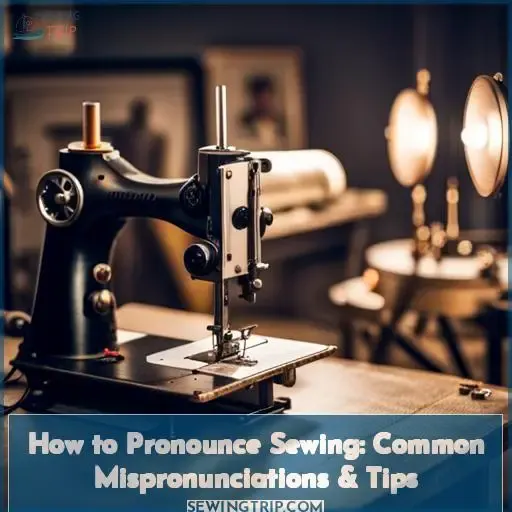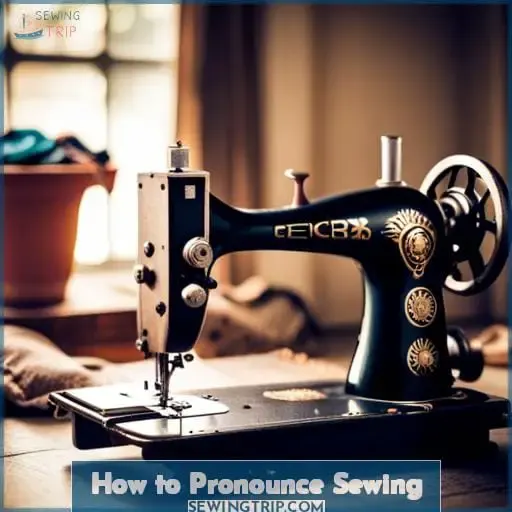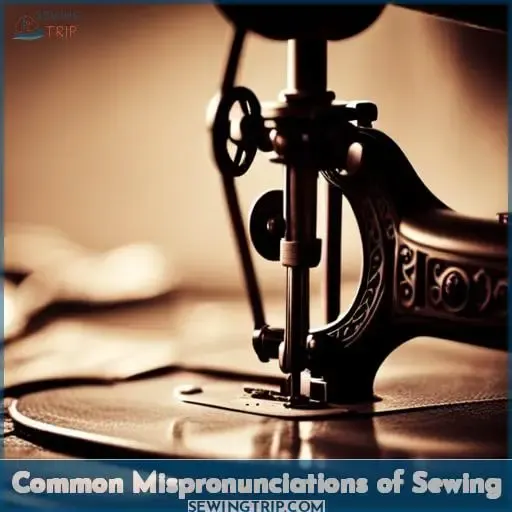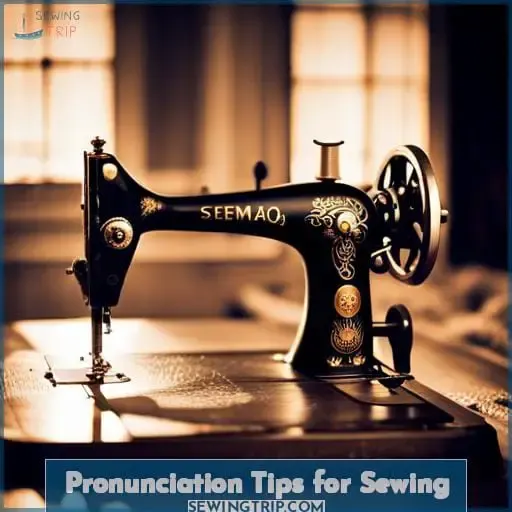This site is supported by our readers. We may earn a commission, at no cost to you, if you purchase through links.
 Are you ready to learn how to pronounce sewing? Many people struggle with the correct pronunciation of this word, and it can be difficult if English is not your native language. In this article, we’ll break down all the different elements of sewing’s pronunciation as well as common mispronunciations and regional variations.
Are you ready to learn how to pronounce sewing? Many people struggle with the correct pronunciation of this word, and it can be difficult if English is not your native language. In this article, we’ll break down all the different elements of sewing’s pronunciation as well as common mispronunciations and regional variations.
The correct pronunciation of sewing is SO-ing with the emphasis on the first syllable. The w is silent. Some common mispronunciations are to pronounce the w or put the emphasis on the second syllable.
When you break down the word into syllables, it is:
SEW-ing
The first syllable is pronounced like so not sue. Say it out loud and listen to where your emphasis lands to check if you are saying it correctly. Practicing the word in isolation and then using it in a sentence can help train your mouth and ears.
Don’t get discouraged if it takes time to re-learn a new way of pronouncing a word you’ve said incorrectly in the past. With a little focus and repetition, the proper pronunciation will become natural.
Table Of Contents
Key Takeaways
- The correct pronunciation of sewing is SO-ing (emphasis on the first syllable, silent w).
- Common mispronunciations include pronouncing the w or putting emphasis on the second syllable.
- Regional accents may affect vowel sounds, but the primary pronunciation remains SOH-ing.
- The breakdown of pronunciation is: the s sound (as in say); the eh vowel sound; the w sound (similar to whistle); followed by the short ih sound (like tip); and the ng sound (reminiscent of sing or ring).
How to Pronounce Sewing
You’d say it like so-ing, with the s sounding like in say and the o like in nose. Grasp those basic sewing techniques first – how to thread a needle and knot it, how to pin patterns and cut fabric.
Amass quality sewing equipment next – shears, needles, thread, pins, measuring tools, an iron.
Tackle engaging sewing projects like dresses, quilts, pillows, bags. Absorb pro tips on finishing seams neatly, handling tricky fabrics, installing zippers.
Soon your passion for sewing will unfurl into textile mastery, each stitched creation a badge of honor.
Common Mispronunciations of Sewing
Many people mistakenly say SOW-ing instead of the correct SOH-ing for sewing. This mispronunciation has become common, especially among some American English speakers. However, it’s still incorrect. Other mispronunciations include SEH-wing and even SOO-ing.
The proper pronunciation uses the long O sound as in toe for the first syllable. Regional accents can lead to different vowel sounds, but the primary pronunciation remains SOH.
Language learners in particular should be aware of these potential mispronunciations. With a pronunciation guide or lesson, the correct SOH sound for sewing can be mastered. But repeated practice is essential until this less common word flows naturally in speech.
Mastering the proper vowels takes focus and work, but correct pronunciation’s worth the effort for effective communication.
Pronunciation Tips for Sewing
Sewing can be tricky to pronounce if you’re unfamiliar with the word. To get it right, start by making the hissing ‘s’ sound, just as you would say ‘sun’. Next, let your mouth open into the ‘eh’ vowel sound, like the beginning of ‘end’.
Finish with a ‘w’, pursing your lips as if you were going to whistle. Don’t forget the short ‘ih’ vowel, the same sound that’s in ‘tip’. End by bringing your lips together to make the ‘ng’ sound that’s in ‘sing’. With practice, you’ll be pronouncing sewing like a pro in no time.
Pronouncing the S Sound
Don’t let that tricky ‘s’ in sewing throw you off – gently close your teeth on your bottom lip as you push the air out.
| Technique | Example |
|---|---|
| Place tongue tip behind bottom teeth | Sea salt |
| Shape lips in a tight circle | Sip slowly |
| Feel air hiss through teeth | Snake slithers |
| Let ‘s’ ring and resonate | Sing a song |
With dedicated practice of proper sibilant sound formation, your sewing vocabulary will sound sublime.
Pronouncing the E Sound
The long e sound in sewing brightens like the beaming sun at noon. When pronounced clearly, that long e vowel rings out, articulating your mastery of the word. Focus on your sound formation, voicing the e with precise clarity. Let it beam brightly from your lips, bringing light and energy to the word.
With practice, your pronunciation of sewing will shine, illuminating your speech with skill and passion.
Pronouncing the W Sound
You’ll want to round those lips to say ‘w’ in ‘sewing’. Pronouncing the ‘w’ sound requires attunement to subtle pronunciation variations across dialects. Linguistic insights into sound articulation reveal the ‘w’ demands careful shaping of the lips.
Phonetics studies illuminate dialect differences; for example, some pronounce ‘w’ with the lips barely rounded while others exaggerate rounding. Mastering ‘w’ articulation takes mindfulness, but allows you to sew words together fluidly.
Pronouncing the I Sound
You’ve heard the /s/, say the /ɪ/ like ship. The vowel in sew makes an /ɪ/ sound, the short i as in ship. This sound varies between long and short in different accents. Learning phonetic symbols helps you master pronunciation no matter the regional accent.
With practice pronouncing different vowel lengths, you’ll speak sewing fluently in diverse dialects. Sewing has subtle sound shifts, but you can grasp them through ongoing pronunciation training.
Pronouncing the Ng Sound
You’re making something special, so end it right. The ng sound can trip you up. It has different pronunciations like sing or ring. Practice words with ng to master that sound. Try singing songs or reading tongue twisters.
Beware of common ng mistakes in sewing words like lengthening. Don’t let that tricky ng sound unravel your project.
Pronunciation Variations Across Different English-speaking Regions
Although the pronunciation may vary slightly across English-speaking regions, one thing stays consistent – the love for sewing transcends dialects.
- The American South may draw out the vowels in ‘sewing,’ while New Englanders clip them short. Australians may stress the first syllable, where Brits emphasize the second.
- Accents drift over time as languages evolve, blending with new cultures and communities. Regional quirks remind us that language lives through its people.
- Sewing binds us together, no matter how we pronounce it. The art persists as our shared inheritance, emancipating crafters to create the lives they envision.
Our voices carry the song of humanity – diverse, imaginative, united in creativity. Sewing celebrates our diverse dialects while stitching a common language of empowerment.
Frequently Asked Questions (FAQs)
What types of sewing machines are available? There are home sewing machines, industrial machines, embroidery machines, sergers, and overlock machines. Home machines can be mechanical or computerized. Features vary by model.
You’ve got options when it comes to sewing machines. Home versions range from basic mechanical to high-tech computerized, while industrial machines handle heavy-duty jobs. Embroidery and serger machines have specialty functions. Focus on the features you need—ask experienced sewers for recommendations.
Conclusion
Sewing is pronounced ‘so-ing’ in UK English and ‘sow-ing’ in US English. To pronounce it correctly, start by pronouncing the ‘s’ sound as in ‘say’, the ‘e’ sound as in ‘nose’, and the ‘w’ sound as in ‘ship’.
Dependin’ on the English-speakin’ region, the pronunciation of sewin’ may vary slightly. However, by followin’ these tips, you can ensure that you pronounce sewin’ correctly.










